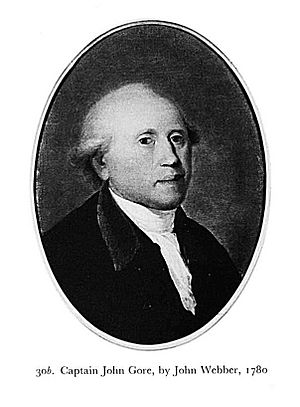John Gore (Royal Navy officer, died 1790) facts for kids

John Gore (born around 1730 – died 10 August 1790) was a brave sailor from the British Colony of Virginia. He sailed around the world four times with the Royal Navy in the 1700s. He also joined Captain James Cook on his famous trips to explore the Pacific Ocean.
Contents
Little is known about John Gore's early life. He was likely born in the Colony of Virginia around 1729 or 1730. His first record in the navy books is from 1755. He joined HMS Windsor in Portsmouth as a midshipman. A midshipman was a junior officer in training.
Sailing Around the World
Five years later, Gore passed his lieutenant's exam. He then became a master's mate on HMS Dolphin. On this ship, Gore sailed around the world two times. First, he sailed under John Byron. Then, he sailed under Samuel Wallis. These trips gave him great experience in the Pacific Ocean.
His knowledge of long navy trips was very useful. This led to him joining James Cook's first big mission.
Joining Captain Cook's First Voyage
In 1768, John Gore joined Cook's mission. They aimed to record the Transit of Venus in Tahiti. They also searched for a large southern land called Terra Australis. Gore was on HMS Endeavour. He started as the third-in-command. This meant he was the 3rd Lieutenant. Cook was the 1st Lieutenant. Zachary Hicks was the 2nd Lieutenant.
Gore had been to Tahiti before with Wallis's Dolphin. This made him very helpful to Cook. He knew a lot about the island.
Exploring New Lands
In 1769, the Endeavour was mapping the coast of New Zealand. During this time, there was a disagreement over a piece of cloth. Gore became the first person on the trip to shoot a Māori person.
Later, on 14 July 1770, the expedition was sailing up the eastern coast of Australia. Gore became famous for being the first person to shoot a kangaroo. This was done for scientific study.
After Cook's First Voyage
After returning to England, Gore went on another trip in 1772. He joined the botanist Joseph Banks. Banks had also been on Cook's first Pacific trip. They went on a private science trip to Iceland and the Hebrides. Gore and Banks might have become friends. Banks was later in charge of Gore's will. This trip ended after Cook had already started his second Pacific voyage.
Joining Cook's Third Voyage
In 1776, Cook and the navy called on Gore again. He joined HMS Resolution as the first lieutenant. This was for Cook's third voyage. The Resolution explored the Pacific. They were looking for the famous Northwest Passage. Gore saw the American continent from its west coast. This was the land where he was born.
Taking Command
Later, Cook died in Hawaii. Charles Clerke, who was captain of Resolution's sister ship HMS Discovery, took command of the expedition. Gore then took command of Discovery in Clerke's place.
When Clerke also died shortly after, Gore became responsible for the entire expedition. He led the ships back home to England. They arrived on 4 October 1780. This was more than a year after he took command. He was officially made a captain on 2 October 1780.
Later Life and Recognition
To honor his achievements, John Webber painted Gore's portrait. Webber had also painted Cook before. The navy made Gore an honorary post-captain. He was offered the rooms at the Greenwich Hospital that Captain Cook had used. John Gore died on 10 August 1790. He had sailed around the world four times.
Legacy and Family
John Gore had a son named John (born 1774). His son also became a Royal Navy Officer. He reached the rank of captain in 1821. He later moved to Australia in 1834. This made him one of the first free settlers there.
Little is known about Gore's wife, Ann Gore. She received a navy widow's pension from 1790.
Gore's grandson, Graham Gore, also became an explorer. He was part of John Franklin's unlucky attempt to find the Northwest Passage. This was almost 70 years after his grandfather had tried to find it.
Places Named After John Gore
Gore Point and the Gore Peninsula are in the Alaskan Kenai fjords. These places were named after John Gore. Captain Nathaniel Portlock named them. Portlock was also on Cook's third voyage. He explored the Pacific Northwest of America in the late 1700s. There are also several places in Australia and New Zealand named after John Gore.

